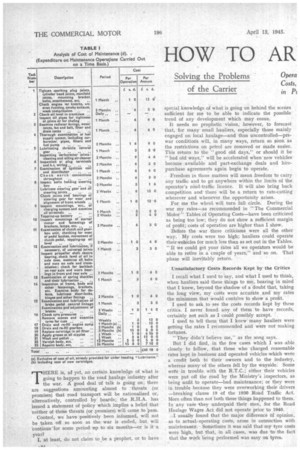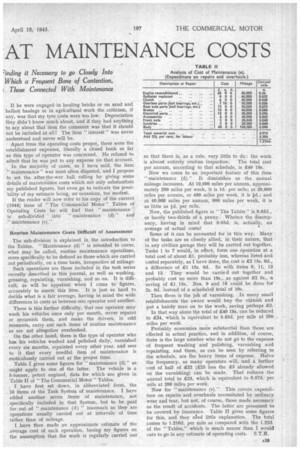HOW TO AR AT MAINTENANCE COSTS
Page 26

Page 27

If you've noticed an error in this article please click here to report it so we can fix it.
Solving the Problems of the Carrier
THERE is ag yet, no certain knowledge of what is going to happen to the road haulage industry after the war. S. good deal of talk is going on; there are suggestions amounting almost to threats (or promises) that road transport will be nationalized or, alternatively, controlled by boards; the R.H.A. has issued a statement of policy which implies a belief that neither of those threats (or promises) will come to 'pass.
Control, we have positively been informed, will not be taken off so soon as the war is ended, but will -eontinue'for some period up to six months—or is it a ,year?
I, at least, do not claim to be a prophet, or to have special knowledge of what is going on behind the scenes sufficient for me to be able to indicate the possible trend of any development which may ensue.
It needs no prophetic vision, however, to forecast that, for many small hauliers, especially those mainly engaged onlocal haulage—and thus uncontrolled—prewar conditions will, in many ways, return so soon as the restrictions on petrol are removed or made easier. This return to the "good old days," or should it be "bad old ways," will be accelerated when "new vehiclesbecome available and part-exchange deals and hirepurchase agreements again begin to operate.
-Freedom in those matters will mean freedom to carry any traffic and to go anywhere within the limits of the operator's road-traffic licence. It will also bring back competition andthere will be a return to rate-cutting wherever and whenever the opportunity arises.
For me the wheelwill turn full circle. During the war my rates—as recommended in " The Commercial Motor" Tables of Operating Costs—have been criticized as being too low; they do not show a sufficient margin of profit; costs of operation are higher than I show.
Before the war these criticisms were all the other way. My costs were too high; hauliers could operate their avehicles for much less than as set out in 'the Tables. "If we could get your rates all we operators would be able to retire in a couple of years," andso on. That phase will inevitably' return.
Unsatisfactory Costs Records Kept by the Critics I recall what I used to -say, and what I used to think, when hauliers said these things to me, bearing in mind that I knew, beyond the shadow of a doubt that, taking the long view, my costs were accurate and my rates the minimum that would contrive to show a profit.
I used to ask to see the costs records kept by these critics. I never found any of them to have records, certainly not such as I could possibly accept.
I used to tell them that I knew many hauliers were getting the rates I recommended and were not making fortunes.
" They didn't believe me," as the song says.
But I did find, in the few cases which I was able closely to follow, that those who charged reasonable rates kept in business and operated vehicles which were a credit both to their owners and to the industry, whereas many of the others fell by the wayside. Some wefe in trouble with the R.T.C.; either their vehicles were put off the road by the Ministry's inspectors, as being unfit to operate—bad maintenance; or they were in trouble because they were overworking their drivers —breaking clause 19 of the 1930 Road Traffic Act. More often than not both these things happened to them.' In any case they underpaid their men, for the Road Haulage Wages Act did not operate prior to 1940.
I usually found that the major difference of opinion, as to actual operating costs, arose in connection with maintenance. Sometimes it was said that my tyre costs were high, but that,, in all cases, was due -to the fact that the work being performed was easy on tyres.
If he were engaged in hauling bricks or on sand and ballast haulage or in agricultural work the criticism, if any, was that my tyre costs were too low. Depreciation they didn't know much about, and if they had anything to say about that item the comment was that it should not be included at all! The item " interest " was never understood and never will be. .
Apart from the operating costs proper, there were the establishment expenses, literally a closed book so far as this type of operator was concerned. He refused to admit that he was put to any expense on that account.
In the majority of cases, as I have said, the item • "maintenance " was most often disputed, and I propose to set the after-the-war ball rolling by giving some details of maintenance costs which not only substantiate my published figures, but even go to indicate the possibility of my estimate being, on occasions, too modest.
If the reader will now refer to his copy of the current (1944) issue of "The Commercial Motor" Tables of Operating Costs he will find that "maintenance " is sub-divided into "maintenance (d)" and • " maintenance (e)."
Routine Maintenance Costs Difficult of Assessment The sub-division is eXplained in the introduction to the Tables. " Maintenance (d)" is intended to cover, what may be called, routine maintenance operations, more specifically to be defined as those which are carried out periodically, on a time basis, irrespective of mileage'.
Such operations are those included in the task series recently described in this journal, as well as washing, greasing, repainting, varnishing, and so on, It is difficult, as will be appatent when I come to figures, accurately to assess this item. It is just as hard to decide what is a fair average, having in mind the wide differences in costs as between one operator and another.
There is this further difficulty, that one operator may wash his vehicles once only per month, never repaint or revarnish them, and make the drivers, in odd moments, carry out such items of routine maintenance as are not altogether overlooked.
On the other hand, there is the type of operator who has his vehicles washed and polished daily, varnished every six months, repainted every other year, and sees to it that every needful item of maintenance is meticulously carried out at the proper time.
Table I gives some figures for "maintenance (d) " as might apply to one of the latter. The vehicle is a 5-toriner, petrol engined, data for which are given in Table II of "The Commercial Motor" Tables.
I have first set down, in abbreviated form, the 16 items of the Task System of maintenance. I have added another seven items of maintenance, not specifically included in that System, but to be paid for out of "maintenance (d) " inasmuch as they are operations usually carried out at intervals of time rather than of mileage.
I have then made an approximate estimate of the average cost of each operation, basing my figures on the assumption that the work is regularly carried out so that there is, as a rule, very little to do : the work is almost entirely routine inspection. The total cost per annum, according to that schedule, is £40 18s.
Now we come to an important feature of this item "maintenance (d)." It diminishes as the annual mileage increases. At 10,000 miles per annum, approximately 200 miles per week, it is Id. per mile; at 20,000 miles per annum, or 400 miles per week, it is id.; and at 40,000 miles per annum, 800 miles per week, it is as little as id. per mile.
Now, the published figure in "The Tables" is 0.65d., or barely two-thirds of a penny.' Whence the discrepancy, having in mind that 0:65d. is, actually, an
average of •actual costs? •
Some of it can be accounted for in this way. Many of the tasks are so closely allied, in their nature, that in any civilian garage they will be carried out together. Tasks 1 to 7 would, in effect, form one operation at a total cost of about £1, probably less, whereas listed and costed separately, as I have done, the.cost is £2 15s. 6d., a difference of El 15s. 6d. So with items 8, 11, 12 and 13. • They would be carried out together and probably cost no more than 10s., as against £2 5s., a saving of £1 15s. Nos. 9 and 10 could be done for 2s. fid. instead of a scheduled total of 10s.
Then there is the job of varnishing. • In many small establishments the owner would buy the varnish and put a hahdy man on to the work, saving perhaps £3. In that way alone the total of £40 18s. can be reduced to £34, which is equivalent to 0.85d, per mile at 200 miles per week.
Probably economies more substantial than those are effected in actual practice, and in addition, of course, there is the large number who do not go to the expense of frequent washing and polishing, varnishing and repainting, and these, as can be seen by referring to the schedule, are the heavy items of expense. Halve the frequency, as many operators will, and a further cost of half of 822 (225 less the £3 already allowed on the varnishing) can be made. That reduces the annual total to £23, which is equivalent to 0.57d; per mile at 200 miles per week.
Now for "maintenance (e)." This covers expenditure on repairs and overhauls necessitated by ordinary wear, and tear, but not, of course, those made necessary as the result of accidents. The latter are presumed to be covered by insurance. Table II gives some figures for this, and they need little explanation. The total comes to 1.216d. per mile as compared with the 1.22d. of the "Tables," which is much nearer than I would care to.go in any estimate of operating costs. S.T.R.




















































